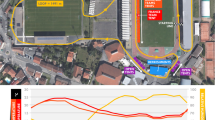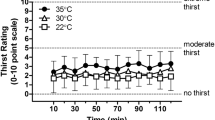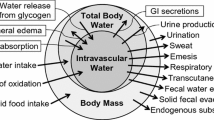Summary
Twenty-one experienced runners were studied before, during and immediately after a marathon race to ascertain whether either depletion of energy substrate or rise in body temperature, or both, contribute to laterace slowing of running pace. Seven runners drank a glucose/electrolyte (GE) solution ad libitum (Na− 21 mmol 1−1, K+ 2.5 mmol l−1, Cl− 17 mmol l − l, PO4 2− 6 mmol 1−1, glucose 28 mmol 1−1) throughout the race; 6 drank water and 8 drank the GE solution diluted 1:1 with water. Although average running speeds for the three groups were not significantly different during the first two-thirds (29 km) of the race, rectal temperature was significantly higher (P < 0.05) and reduction of plasma volume was greater (P <0.05) in runners who replaced sweat losses with water. During the last one-third of the race, the average running pace of the water-replacement group slowed by 37.2%; the pace slowed by 27.9% in the 8 runners who replaced their sweat loss with GE diluted 1:1 with water (1/2 GE) and 18.2% in runners who replaced fluid loss with full-strength solution (GE). Eleven runners (5 in the water group, 4 in the 1/2 GE group and 2 in the GE group) lapsed into a walk/run/walk pace during the last 6 miles of the race. Ten of these had a rectal temperature of 39° C or greater after 29 km of running, and plasma volume in these runners was reduced by more than 10%. Only 1 runner among those who ran steadily throughout the race had such an elevation of temperature and reduction of plasma volume. A significant reduction in plasma glucose concentration (less than 3.3 mmol 1−1) was present in 5 of the 11 walk/run/walk subjects and in none of those who ran steadily. The results are consistent with the suggestion that assumption of the walk/run/walk pace resulted from high body temperature associated with either diminished plasma volume or low blood sugar.
Similar content being viewed by others
References
Anon (1974) Biggest And Best-Boston. Runners World 9:14
Benzinger TH (1959) On physical heat regulation and the sense of temperature in man. Proc Natl Acad Sci USA 45:645–659
Bergstrom J, Hermansen L, Hultman E, Salter B (1967) Diet, muscle glucogen and performance. Acta Physiol Scand 71:140–150
Briggs AP, Koechig I (1923) Some changes in the composition of blood due to the injection of insulin. J Biol Chem 58:721–730
Cade R, Free JH, de Quesada AM, Shires DL, Roby L (1971) Changes in body fluid composition and volume during vigorous exercise by athletes. J Sports Med Physical Fitness 11:172–178
Cade R, Spooner G, Schlein E, Pickering M, Dean R (1972) Effect of fluid electrolyte and glucose replacement during exercise on performance, body temperature, rate of sweat loss and compositional changes of extracellular fluid. J Sports Med Phys Fitness 12:150–156
Cohen I, Zimmerman AL (1969) Changes in serum electrolyte levels during marathon runnings. S Afr Med J 43:893–896
Costill DL, Kammer WF, Fisher A (1970) Fluid ingestions during distance running. Arch Environ Health 21:520–525
Dayton DM (1970) The design of educational experiments. McGraw-Hill, New York, pp 1–18
Dill DB, Costill DL (1974) Calculation of percentage changes in volumes of red blood cells and plasma dehydration. J Appl Physiol 37:247–248
Garrett HE, Woodworter M (1960) Statistics in physiology and education, 5th edn. Longmans Green, New York, pp 276–309
Gordon B, Kohn LD, Levin SA, Mahon M, den Sekiver W, Whiting WB (1925) Sugar content of the blood of runners following a marathon race. JAMA 85:508–509
Hanson PG, Zimmerman SW (1979) Exertional heatstroke in novice runners. JAMA 242:154–157
Hommen N (1985) Effect of volume depletion on the thermoregulatory system during exercise. Masters Thesis, University of Florida, May 1985
Killingsworth L, Savory J (1972) Manual nephelometric methods for immunochemical determinations of IGG, IGA, and IGM in human serum. Clin Chem 18:355–359
Levin SA, Gordon B, Derick CL (1924) Some changes in chemical constituents of blood following a marathon race. JAMA 82:1778–1779
Nadel ER, Fortney SM, Wenger CB (1980) Effect of hydration state on circulatory and thermal regulations. J Appl Physiol 49:715–721
Nose H, Mack GW, Lhi H, Nadel ER (1988) Role of osmolarity and plasma volume during dehydration in humans. J Appl Physiol 65:325–331
Pitts RF (1974) Physiology of the kidney and body fluids. 3rd edn. Yearbook Medical, Chicago
Rowell LB, Marx HJ, Bruce RA, Conn RD, Kusumi F (1966) Reductions in cardiac output, central blood volume and stroke volume with thermal stress in normal man during exercise. J Clin Invest 45:1801–1816
Schlein EM, Jensen D, Knochel JP (1973) The effect of plasma water loss on assessment of muscle metabolism during exercise. J Appl Physiol 34:568–572
Sohar E, Shapira Y, Nir M, Hellman M (1965) Comparison of methods for determination of the sodium content of sweat. Nature 205:604–605
Syndham CH (1977) Heat stroke and hyperthermia in marathon runners. Ann N Y Acad Sci 301:128–138
van Beaumont W, Greenleaf JE, Juhos L (1972) Disproportional changes in hematocrit, plasma volume, and proteins during exercise and bed rest. J Appl Physiol 33:55–61
Wide L (1969) Radioimmunoassays employing immunosorbents. Acta Endocrinol [Suppl] 142:207–221
Wilkenson JH (1970) Isoenzymes, 2nd edn. Lippincott, Philadelphia
Wyndham CH, Strydom NB (1969) The danger of inadequate water intake during marathon running. S Afr Med J 43:893–896
Zierler KL (1966) Possible mechanisms of insulin action on membrane potential and ion fluxes. Am J Med 40:735–739
Author information
Authors and Affiliations
Rights and permissions
About this article
Cite this article
Cade, R., Packer, D., Zauner, C. et al. Marathon running: physiological and chemical changes accompanying late-race functional deterioration. Europ. J. Appl. Physiol. 65, 485–491 (1992). https://doi.org/10.1007/BF00602353
Accepted:
Issue Date:
DOI: https://doi.org/10.1007/BF00602353




